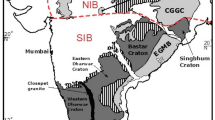Summary
A comprehensive geological and petrological investigation has been undertaken in an area of about 10 000 km2 in the Indian Himalaya (S-Lahul, Himachal Pradesh). The development of mineral assemblages in metamorphic rocks of medium grade is considered to be a dominant Alpine event, although almost exclusively Paleozoic and Precambrian rocks have been involved. The Barrowian type of this metamorphism, ranging from the anchi- to the sillimanite zone, took place under the elavated T-gradient of about 4°C/100 m. It is suggested that “normal” geothermal conditions prevailed only in the outermost zone of this orogenic belt. In the Late Tertiary this metamorphic series has been moved as a huge nappe upon the Lower Himalaya. During this process a unique feature of reverse metamorphism has been formed. It can be shown that this feature was caused by a combination of metamorphism and very rapid tectonic movements.
Zusammenfassung
Ein etwa 10 000 km2 großes Gebiet des Indischen Himalaya (S-Lahul, Himachal Pradesh) wurde einer umfassenden geologischen und petrographischen Bearbeitung unterzogen. Die Ausbildung der in den mittelgradig metamorphen Gesteinen vorliegenden Mineralparagenesen wird als ein dominant alpines Ereignis betrachtet, obwohl fast nur paläozoische und präkambrische Gesteine einbezogen wurden. Die Metamorphose selbst ist von Barrow-Typus und reicht von der Anchi- bis zur Sillimanitzone. Sie fand unter einem erhöhten Temperaturgradienten von etwa 4°C/100 m statt. Nur in der äußersten Zone des Orogens entsprach der Gradient etwa normalen geothermischen Verhältnissen. Im Spättertiär wurde diese alpin-metamorphe Serie in Form einer mächtigen Kristallindecke dem Niedrigen Himalaya aufgeschoben. Dabei wurde eine einzigartige Zone inverser Metamorphose ausgebildet. Es konnte gezeigt werden, daß diese inverse Metamorphose durch das Zusammenwirken von Metamorphose und sehr rasch ablaufender Tektonik entstand.
Similar content being viewed by others
References
Althaus, E., 1967: The triple point andalusite-sillimanite-kyanite. Contr. Min. Petr.16, 29–44.
Chaku, S. K., 1972: Geology of Chauri Tehsil and adjacent area, Chamba District, H. P. Himalayan Geology2, 404–414.
Frank, W., 1972: Progressive alpine Metamorphose im Himalaya. “Habilitationsschrift”, University of Vienna; 78p., unpublished.
— andG. Fuchs, 1970: Geological investigations in West Nepal and their significance for the geology of the Himalayas. Geol. Rundschau59, 552–580.
Fuchs, G., 1967: Zum Bau des Himalaya. Österr. Akad. Wiss., Math.-naturwiss. Kl., Denkschr.113, 1–211.
— andW. Frank, 1970: The geology of West Nepal between the rivers Kali Gandaki and Thulo Bheri. Jb. Geol. Bundesanst. (Wien) Sonderbd.18, 1–103.
— andV. J. Gupta, 1971: Palaeozoic stratigraphy of Kashmir, Kishtwar and Chamba (Panjab Himalayas). Verh. Geol. Bundesanst. (Wien) Jg.1971, 68–97.
— andH. Mostler, 1972: Der erste Nachweis von Fossilien (kambrischen Alters) in der Hazira-Formation, Hazara, Pakistan. Geol. Paläont. Mitt. Innsbruck2, 1–12.
Fyfe, W. S., 1969: Some second thoughts on Al2O3−SiO2. Amer. J. Sci.267, 291–296.
Gansser, A., 1964: Geology of the Himalayas. London-New York-Sydney: John Wiley & Sons Ltd., 289 p.
Hansen, E., 1971: Strain facies.-Berlin-Heidelberg-New York: Springer.
Hayden, H. H., 1904: The geology of spiti.-Mem. Geol. Surv. India36, 122–201.
Holdaway, M. J., 1971: Stability of andalusite and the aluminium silicate phase diagram. Amer. J. Sci.271, 97–131.
Hoschek, G., 1969: The stability of staurolite and chloritoid and their significance of pelitic rocks. Contr. Min. Petr.22, 208–232.
Hurley, P. M., 1968: Absolute abundance and distribution of Rb, K and Sr in the Earth. Geochim. Cosmochim. Acta32, 273–283.
Jäger, E., A. K. Bhandari, andV. B. Bhanot, 1971: Rb−Sr Age-determinations on biotites and whole rock samples from the Mandi and Chor granites. Himachal Pradesh, India. Eclogae Geol. Helv.64, 521–527.
Jaeger, J. C., 1957: The temperature in the neighbourhood of a cooling intrusiv sheet. Amer. Sci.255, 306–318.
Pilgrim, G. E., andW. D. West, 1928: The structure and correlation of the Simla rocks. Mem. Geol. Surv. India53, 1–140.
Powell, C. McA., andP. J. Conaghan, 1973: Polyphase deformation of Phanerozoic rocks of the Central Himalayan Gneiss. J. Geol.81, 127–143.
Richardson, S. W., M. C. Gilbert, andP. M. Bell, 1969: Experimental determination of kyanite-andalusite and andalusite-sillimanite equilibrias; the aluminium silicate triple point. Amer. J. Sci.267, 513–541.
Sander, B., 1930: Gefügekunde der Gesteine. Wien: Springer, 352 p.
Srikantia, S. V., andR. P. Sharma, 1972: The Precambrian salt deposits of the Himachal Pradesh Himalaya. Its occurence, tectonics and correlation. Himalayan Geology2, 222–238.
Turekian, K. K., andL. Kulp, 1956: The geochemistry of strontium. Geochim. Cosmochim. Acta10, 245–296.
Valdiya, K. S., 1965: Petrography and sedimentation of these dimentary zone of Southern Pithoragarh. U. P. Himalaya. Wadia Comm. Vol., Mining and Metallurgical Inst. of India. 521–544.
Wadia, D. N., 1931: The syntaxis of the North-West Himalaya: Its rocks, tectonics and orogeny. Rec. geol. Surv. India65, 189–220.
Wensink, H., 1973: Newer paleomagnetic results of the Deccan traps, India. Tectonophysics17, 41–59.
Winkler, H. G. F., 1967: Petrogenesis of metamorphic rocks. Berlin-Heidelberg-New York: Springer.
Author information
Authors and Affiliations
Additional information
Dedicated to Prof. Dr. Dr. h. c.B. Sander on the occasion of his 90th birthday.
With 13 Figures
Rights and permissions
About this article
Cite this article
Frank, W., Hoinkes, G., Miller, C. et al. Relations between metamorphism and orogeny in a typical section of the Indian Himalayas. TMPM Tschermaks Petr. Mitt. 20, 303–332 (1973). https://doi.org/10.1007/BF01081339
Received:
Issue Date:
DOI: https://doi.org/10.1007/BF01081339




